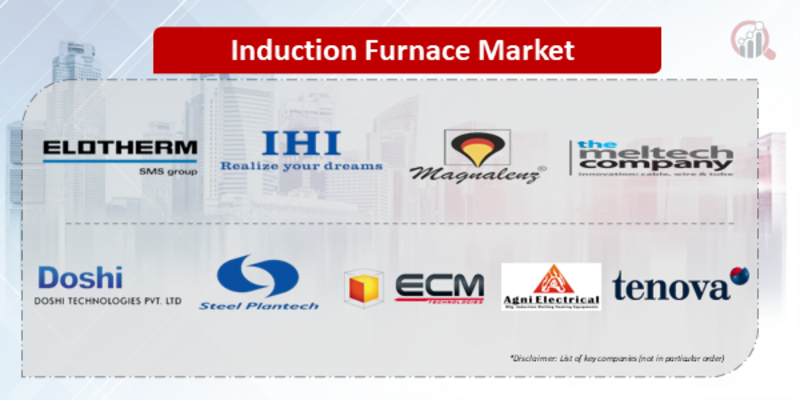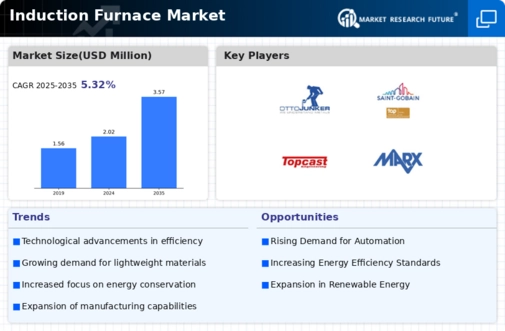Top Industry Leaders in the Induction Furnace Market

*Disclaimer: List of key companies in no particular order
Latest Induction Furnace Market Company Updates:
Competitive Landscape of the Induction Furnace Market: A 600-word Analysis
Analyzing the strategies, trends, and key factors influencing market share is crucial for understanding the current scenario and future direction of this thriving industry.
Key Players and Their Strategies:
Global Leaders: Companies like Electrotherm, Danieli, SMS, Inductotherm Corporation, IHI, and OTTO JUNKER hold significant market share, leveraging their extensive experience, strong R&D capabilities, and global reach. Their strategies focus on product portfolio diversification, technological advancements, geographical expansion, and strategic partnerships. For instance, Inductotherm's acquisition of Hertwich Engineering strengthened its position in the aluminum melting segment.
Niche Specialists: Regional players like Rexroth Indramat GmbH, Asea Brown Boveri (ABB), and Ajax Magnethermic Corporation cater to specific market segments or geographical regions. They capitalize on their specialization and in-depth market knowledge to carve out a niche. Ajax Magnethermic, for example, excels in high-frequency furnaces for critical applications like medical implants.
Emerging Players: New entrants, often driven by innovative technologies and disruptive business models, are also making their mark. Companies like Sinopec, Tenova, and Elkem are introducing modular furnace designs, digital solutions for enhanced process control, and recycling-focused technologies. Sinopec's focus on energy-efficient and environmentally friendly melting solutions resonates with the growing emphasis on sustainability.
Factors Influencing Market Share:
Product Portfolio: Offering a diverse range of induction furnaces – coreless, medium-frequency, vacuum, etc. – catering to varied capacity, application, and industry needs fosters market penetration.
Technological Advancements: Continuous investment in R&D to develop energy-efficient furnaces, enhance automation, and integrate data analytics capabilities creates a competitive edge.
Geographical Presence: Establishing a strong global network with manufacturing facilities, sales offices, and service centers ensures proximity to customers and responsiveness to their needs.
Sustainability Focus: Developing eco-friendly furnaces with lower emissions and energy consumption aligns with evolving customer preferences and environmental regulations.
Customer Service and Support: Providing comprehensive after-sales support, including spare parts availability, maintenance programs, and technical expertise, builds customer loyalty and trust.
New and Emerging Trends:
Digitalization: Integration of Industrial IoT (IIoT) solutions for real-time monitoring, predictive maintenance, and process optimization is gaining traction.
Modular Furnaces: Flexible and scalable furnace designs enable faster installation, easier customization, and adaptation to changing production needs.
Recycling Focus: Development of furnaces specifically designed for efficiently melting scrap metal addresses sustainability concerns and reduces reliance on virgin materials.
Energy Efficiency: Optimizing furnace design and processes to minimize energy consumption and environmental impact is a key growth driver.
Regional Growth: Emerging economies in Asia-Pacific and Latin America present significant growth potential, attracting increased investments and market expansion strategies.
Overall Competitive Scenario:
The induction furnace market is witnessing intensifying competition driven by technological advancements, rising customer expectations, and a growing focus on sustainability. Established players are constantly innovating to maintain their positions, while niche specialists and new entrants are disrupting the market with tailored solutions and unique propositions. Collaboration and partnerships are also becoming increasingly common, paving the way for joint development and market penetration.
The key to success in this dynamic landscape lies in adaptability, responsiveness, and a commitment to continuous improvement. Understanding the evolving customer needs, embracing technological advancements, and prioritizing sustainability will be crucial for players to thrive in the competitive induction furnace market of the future.
SMS Elotherm GmbH (Germany):
• October 2023: Announced a partnership with a leading Chinese steel producer to supply a high-efficiency induction furnace for melting stainless steel scrap. (Source: SMS Elotherm press release)
Meltech Ltd (UK):
• November 2023: Launched a new range of compact induction furnaces for small-scale melting applications, targeting jewelry makers and research institutions. (Source: Meltech website)
Tenova SpA (Italy):
• September 2023: Unveiled its "E-Steel" technology for electric steelmaking, which includes advanced induction furnace systems for optimized energy consumption. (Source: Tenova website)
Doshi Technologies Pvt. Ltd (India):
• October 2023: Commissioned a custom-designed induction furnace for a leading Indian foundry, achieving significant improvements in melting speed and metal quality. (Source: Doshi Technologies press release)
IHI Machinery and Furnace Co. Ltd (Japan):
• November 2023: Successfully tested a pilot plant for a new "direct reduction-induction melting" process, aimed at reducing carbon emissions in steelmaking. (Source: Nikkei Asian Review)
Top listed global companies in the industry are:
SMS Elotherm GmbH (Germany)
Meltech Ltd (UK)
Tenova SpA (Italy)
Doshi Technologies Pvt. Ltd (India)
IHI Machinery and Furnace Co. Ltd(Japan)
JP Steel Plantech Co. (Japan)
ECM Technologies (Netherlands)
Agni Electrical Pvt. Ltd (India)
Pees Induction Equipment’s Pvt.Ltd (India)
Magnalenz (India)

